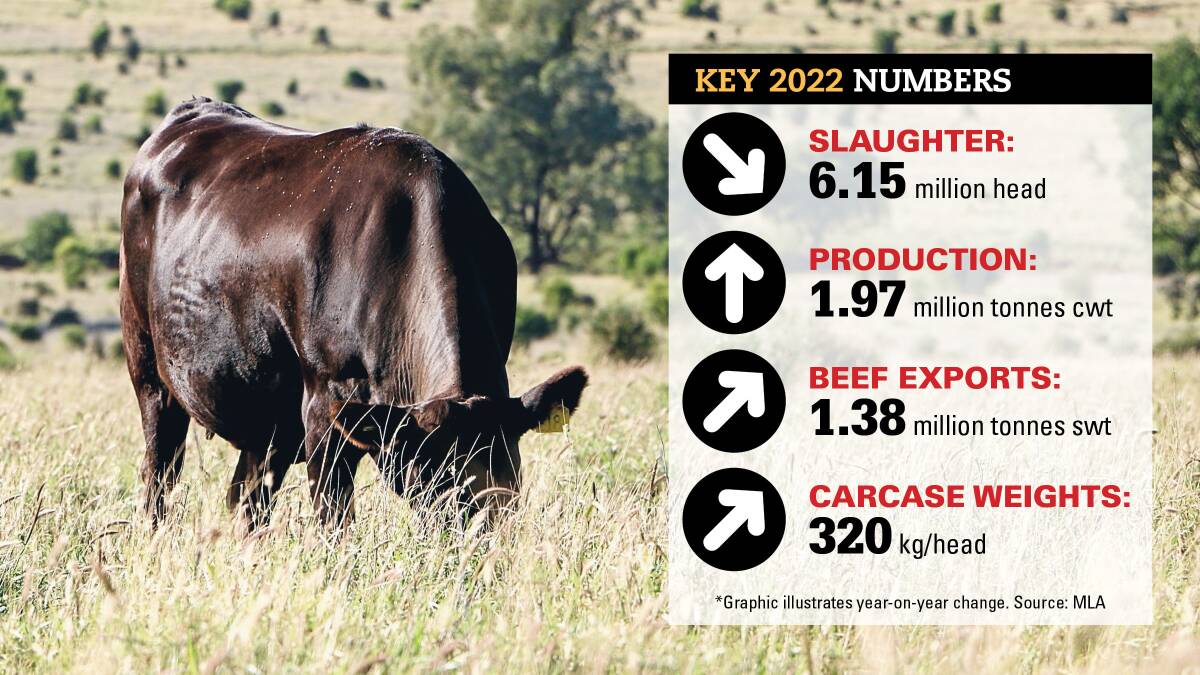
YOUNG cattle prices are expected to drop back more than 150 cents a kilogram carcase weight by the end of the year as supply lifts and the empty spots in grassed-up paddocks get closer to being full, according to the latest forecasts from Meat & Livestock Australia.
Subscribe now for unlimited access to all our agricultural news
across the nation
or signup to continue reading
The team of industry analysts brought together to nut out a predicted Eastern Young Cattle Indicator for the organisation's six-monthly cattle industry outlook have put the key benchmark at 953c/kg by the end of December, compared to its current 1120c/kg.
While investment in young cattle from here will be less hectic, just how strong the unprecedented kickback from drought has been on the cattle market is very clear in MLA's outlook.
Slaughter numbers have been revised down - due to processor challenges headlined by labour shortages - to reach 6.15 million head in 2022. While that will be a lift on last year, it is only at a rate of 2.2 per cent.
After two years of back-to-back slaughter declines of 16pc, that lift is considered restrained.
MLA's market information manager Stephen Bignell said that level of decreased slaughter, for such an extended period, was rare.
In the 2010 post-drought rebuild slaughter only fell 2 to 3pc for one year.
"In fact, we haven't had such a significant drop in slaughter since the 1970s and that was caused by the global beef market drop, not drought," Mr Bignell said.
The severity of the 2017 to 2019 drought decimated the herd to its lowest level since the 1990s, so the rebuild started from an extremely low base, the MLA outlook report said.
Destocking occurred to such an extent that there is still capacity on many farms to increase their stocking rates, even after three years of sustained rainfall.
These factors are contributing to producers retaining more stock and withholding it from slaughter.
That means the herd rebuild is still on, although it is southern-driven as the north had a disappointing wet season and will need an above-average summer to get its rebuild anywhere near back on track.
MLA is forecasting herd numbers to rise nationally by 6pc to 27.6m head in 2022.
The herd is expected to grow a further 4.6pc by 2024 to reach 28.9 million head.
The big money that has been forked out for young heifers throughout 2020 and 2021 will not be fully realised, in terms of new progeny, until late this year and into next year, MLA analysts pointed out.
ALSO IN BEEF:
Labour woes
A major problem for slaughter volumes moving forward are the continued issues around labour availability, MLA analysts reported.
The beginning of this year saw many abattoirs have to run shorter weeks because of continued public holidays, virus outbreaks or rain making the transportation of livestock difficult. Some facilities are now working a six-day week to try and make up the time lost and to work through the excess supply, the outlook report said.
David Foote, from vertically-integrated beef supply chain business Australian Country Choice, said recovery from COVID-19 and flu disruptions was now almost complete and combined with the opportunity of the Pacific labour scheme, full plant optimisation would soon be very close.
MLA said it was the hope that throughout the rest of this year, with the opening of borders and new visas being issued, labour shortages would ease slightly.
However, it noted there was an eight-month long time lag for training in processing facilities, which could have a significant impact on slaughter numbers moving forward.
Carcase weights up
While slaughter rates are still constrained, carcase weights continue to increase, allowing Australia's beef production to be kept up despite low cattle supply, Mr Bignell said.
Large volumes of cattle on feed are driving the higher carcase weights along with higher prices, which are incentivising producers to increase weights before selling.
Grass-fed product was expected to come on in a significantly bigger way back at the end of this year, Mr Bignell said.
Carcase weights in the first three months of this year reached a national average of 324.4kg per head, which was an incredible 10.8kg higher than the average in 2021. And they are expected to average 320kg for the year.
For all the big news in beef, sign up below to receive our Red Meat newsletter.


